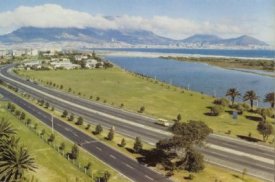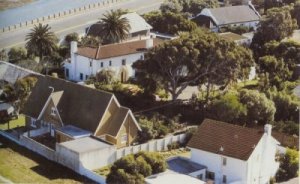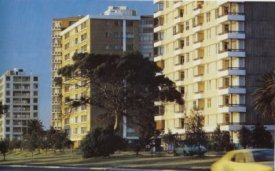Chapter 16 - Another World
War
Inevitably effects of
War showed themselves in the affairs of the Milnerton Estates which,
on December
13, 1939, contributed £25 to the
South African Mayors' Fund, £50 to the Union Unity Fund and five guineas
for "Comforts for Naval Men".
Within a few more weeks,
in February 1940, came an enquiry from the Defence Department for
five morgen of land required for some unspecified purpose. That ill-starred
year ran on, with the launching of the Blitz in Europe, the collapse of France, and the entry of Italy into the struggle.
Ever since
World War I the military authorities had owned a battery site in
Milnerton, purchased in 1914 and transferred on April 7, 1915.
Not without reason did the
Secretary on June 17, 1940, report that the military authorities "required to take
across the weir two guns of say four tons each". The execution
of the plan was semi-comic, for a 12-ton Army crane stuck in the
mud and was disinterred only after many hours of effort!
Apart from the steady growing
list of subscriptions by the Company to War charities, including Comforts
for Naval Men, The Merchant Navy Fund, the Netherlands Relief Fund,
the Finnish Relief Fund and the Y.M.C.A. War Fund, other items in
the Company's minute books showed the local effects of the conflict.
In July 1940 for example 10 guineas went to the Civilian Protective
Services for the Milnerton area, the local equivalent of Britain's Air Raid Precautions. Fresh negotiations with representatives of the
Defence Department occurred in 1942 about an area, 350 yards square,
required for "military purposes" again with no further explanation,
while, surprisingly enough, even the Milnerton Railway came into the
picture when, on five or six occasions, it was required in association
with Messrs. Mann George & Co. "in connection with the salvage
of a certain shipwrecked vessel".
Since the death of his
father and the passing to him of the Baronetcy title, the traditional
family link with Milnerton had been maintained by Sir De Villiers Graaff, who came into the news,
in December 1939, for catching "two European men shooting at wild fowl on
the lagoon" and duly handing them over to the police. Almost
immediately afterwards Sir De Villiers was in the Army, sent up North
and, alas, was taken prisoner by the Germans and fated to spend a
long time in the hands of the enemy. Substantial numbers of men and
women from Milnerton were likewise in the Forces, or otherwise contributing
to the War effort. Yet somehow or other life continued in the township
and there was even a certain amount of development, more particularly
in connection with the new National Road to Malmesbury. "Defence
requirements", it was reported on June 26, 1942, "have created
unexpected difficulties and delays in these important matters and
much detailed negotiation has been and will still be needed with particular
reference to the Marine Drive. . ." So too came reports that,
for defence purposes, "the Government may in the near future
construct a bridge across the Diep River".
As for the Milnerton Local
Board, this became involved during 1940 in a dispute with the Cape
Town City Council and the Divisional Council on a proposed Joint Town
Planning Scheme, bad feeling being caused by the decisions of the
last-named two larger bodies to work out the details on their own,
without consulting any of the landowners, including the Milnerton
Estates. Arguments continued to rage right through the war period.
According to a return prepared
in 1940, the Milnerton Estates holdings in the area of the Local
Board now covered 1 171 acres, of which nearly half, namely 525
acres, located on Jan Biesjes Kraal, was still available
for sub-division. Beyond the Golf Course, covering 221 acres, were
the 199 acres (excluding the roads and public spaces) of the General
Township Area, and the 127 acres of Race Course. Though officially
classed as a section of Paarden Island, another 88 acres
lay within Milnerton and 14 were used as a park.
One
unforeseen and by no means trifling emergency confronted Milnerton
in 1941 when, owing to some obstruction at the weir, the flood gates
jammed and the entire area fronting on the river was suddenly submerged,
with the prospect of a real disaster to most of the town. Unable
to cope with this unaided, the officials had to call in the Army and
the South African Engineering Corps appeared with praiseworthy speed.
So urgent was the position that they were obliged to blow up the
Eastern section of the weir, and the accumulated waters escaped
in the nick of time and Milnerton was saved.
Hints
of prevailing troubles were given on June
15, 1942,
when an enquiry was lodged with the Cape Town City Council as to
whether, "in view of the extreme difficulty in obtaining building
materials, owing to the War", the Council might grant certain
concessions.
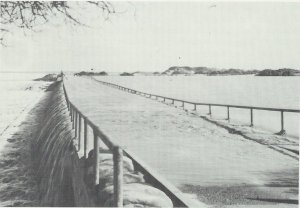
The Weir during the floods- 1940.
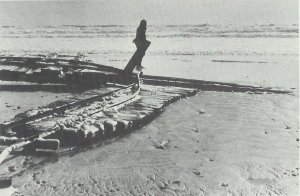
Damage caused by the floods in 1940.
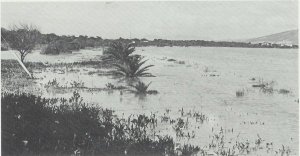
The palm site under water – 1940
On November
6, 1942, the Military authorities
asked the Divisional Council to proceed with the survey of the long-hoped-for
coastal road past Milnerton. Indeed, on a small scale a certain amount
of house-building was still in progress, there being mention of a
group of five dwellings financed by the Company, but at a cost stated
to be 60 per cent above the estimate. So too the Golf Club complained
about "unprecedented difficulties due to war conditions",
one of them being the fact that the proposed widening of the Marine
Drive would radically interfere with its operations. As a result the
Milnerton Estates set a new precedent in 1943 by making a further
grant in aid to the Club of £250.
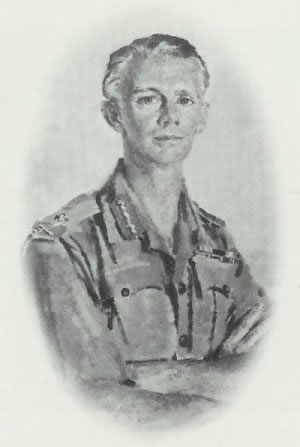
Major-General F. H. Theron – as seen by the
official British Army portrait painter in Cairo during the Second World
War.
Strangely enough it was at the height
of the War that one of the best known personalities in the South
African Forces became a landowner, when, on April 14, 1943, it was
noted that Lots Nos. 137 and 138 in Milnerton Extension No. 1, had
been sold to General Frank Theron for the sum of £414. Several years
were still to pass, however, before this famous military leader could
fulfil his ambition to retire. Not long after another outstanding
Milnerton personality passed away - Fred Botha, for many years Secretary
to the Turf Club.
Following his elevation
to the position of Administrator of the Cape Province, Major G. B. van Zyl had to resign from the
Chairmanship of the Milnerton Estates, though he still lived in the
township, but the idea of
electing Sir De Villiers Graaff as his successor had to wait his release
from an enemy prison camp. During the long years of detention in Germany, the place of Sir De Villiers was taken on the Board
by his mother, the Dowager Lady F. de Villiers Graaff, while, only a few days before the end of hostilities,
his brother D. P. de Villiers Graaff became a director.
All this while, though
on a very reduced scale, activities at the Milnerton Race Course
continued, even if, in consonance with the policy of the South
African Railways, both the fares for passengers and the charges
for conveying horses were in September 1944 increased by 10 per
cent.
Significant of the approaching
end of hostilities was the action of B. Porzig, a member of the "Ex-Servicemen's
Aid Committee". In April 1945 he requested facilities for
the men returning from up North to buy land and build houses
at Milnerton, plus a relaxation of the rule requiring a minimum
expenditure on construction of £2000. But as to Mr. Porzig's suggestion that the figure be reduced to £1500, the Company
regretted it was not possible to depart from their policy. "To
break this rule," he was informed, "would be to open
the door to many similar requests and would also be contrary
to the arrangements made with many earlier purchasers of land."





